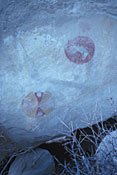|
By Laura Fauth
 It is a rare victory that pleases an oil company executive, a Native American historian and a Sierra Club conservation organizer. Such a win occurred in April when Anschutz Exploration Corporation gave up its plans to drill for oil in a Montana canyon known as Weatherman Draw. Heck, even Interior Secretary Gale Norton was pleased. It is a rare victory that pleases an oil company executive, a Native American historian and a Sierra Club conservation organizer. Such a win occurred in April when Anschutz Exploration Corporation gave up its plans to drill for oil in a Montana canyon known as Weatherman Draw. Heck, even Interior Secretary Gale Norton was pleased.
Weatherman Draw, also known as the Valley of the Chiefs, is sacred to at least 10 Native American tribes. The site is adorned with the largest concentration of multicolored painted art in the Northern Plains, including Native American pictographs of shields, animals and human figures that date back more than 1,000 years.
In April, Anschutz, a Denver-based oil company, agreed to donate its leases for oil and gas rights in the draw to the National Trust for Historic Preservation, which has pledged to let the leases expire. The Bureau of Land Management says it has no plans to permit further leases and will consider formal withdrawal of the 4,268-acre site from mineral leasing in its 2004 management plan.
"The Indian people are very, very happy" with Anschutz's decision, says Howard Boggess, a historian and member of the Crow Tribe. "The BLM never should have sold Anschutz the leases. And Anschutz just walked away without any compensation. It shows that they care about our traditional religion."
Mary Wiper, conservation organizer for the Montana Chapter, is also thrilled by Anschutz's decision. "It was a very commendable thing for the company to do," she says. "We had even joked about it, saying, 'Philip Anschutz is the sixth richest man in America. Wouldn't it be nice if he just gave up the leases?' And he did."
Anschutz is headed by billionaire Philip Anschutz, a major donor to the Bush campaign and the Republican party. His company was awarded rights to drill in Weatherman Draw just 12 days after the Bush inauguration. Anschutz Vice President William Miller says his company recognized the cultural values connected to Weatherman Draw and believed that transferring the leases to the National Trust was "the right thing to do."
Norton also applauded the agreement between Anschutz and the National Trust.
Boggess says the key to victory was persistence - and working with Anschutz rather than the BLM. "At one point, the BLM essentially told us, 'We've made our decision. Go home and don't bother us,'" he says. "Many people told us it would never, ever happen. But we stuck with it and didn't give up."
Wiper says it is a great example of an "activist-driven victory" made possible by basic organizing. In 1999 and 2000, the chapter had people send comments to the BLM on the environmental assessment for the site. Last year, Weatherman Draw was a focal point of the chapter's spring and fall outreach events, with postcards going to Anschutz and the BLM. "A lot of people wrote letters and a lot of people worked long hours," says Wiper.
Club organizers capitalized on the fact that Anschutz is a well known art collector whose collection includes Native American artifacts. When his collection was on view in Washington, D.C., and later at the Joslyn Art Museum in Omaha, Neb., environmentalists and tribal leaders were on hand to raise public awareness about Anschutz's plan to drill in Weatherman Draw.
The Club got involved early on with monitoring administrative processes related to protection of the site. In 1992 it helped nominate Weatherman Draw as an "Area of Critical Environmental Concern" - a designation it finally received from the BLM in 1999. (Unfortunately, the oil and gas leases involved existed before the designation and were considered valid existing rights.)
Boggess credits the coming together of many different Native American tribes as another key to the successful outcome. Tim Mentz of the Standing Rock Sioux, Jimmy Arterberry of the Comanche and Jimmy St. Goddard from the Blackfeet tribe all played an instrumental role in the campaign to protect the sacred valley.
Both Boggess and Wiper also point to a strong collaborative effort between environmental groups and Indian tribes. While Boggess and other tribal leaders often determined the direction of the campaign, the Club took the lead on organizing and public outreach. "Without the Sierra Club and the National Trust it would not have happened," says Boggess.
Native Americans value the Valley of the Chiefs not just for the ancient spiritual drawings it houses, but for the amazing peace and quiet it offers those who travel there for vision quests or prayer ceremonies. "I think it is one of the quietest places on earth," says Boggess.
He is thankful that for now the valley will remain quiet, undisturbed by the roar of oil machinery. "The Valley of the Chiefs is like a church for the Indian people," says Boggess. "We don't build churches or chapels. We are in our church when we can see the sky and our feet touch the earth."
Rep. Nick Rahall (D-W.Va.), an important congressional ally in the campaign to protect Weatherman Draw, says the case highlights the need for a more comprehensive plan to protect sacred Native American sites. "What was proposed at Valley of Chiefs was a wake-up call for action, for the pressing need to protect bona fide Native American sacred sites wherever they lie in the public domain," he says.
Up to Top
|